Video of the Week:
Growing Asparagus
Turfgrass:
It's Not Too Late for Dormant Overseeding of Turfgrass
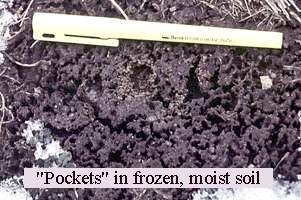
Dormant overseeding is usually done during the winter (December through February) when it is too cold for germination to take place. Spring seedings done in March can be just as successful as dormant seeding, but spring rains may delay plantings. As with any seeding program, it is vital that good seed-soil contact is achieved. There are several methods that are commonly used in dormant seeding.
One method is to seed when there has been a light snowfall of up to an inch over unfrozen soil. This is shallow enough that bare spots can still be seen. Spread seed by hand on areas that need thickening up. As the snow melts it brings the seed into good contact with the soil where it will germinate in the spring.
Another method is dependent on the surface of the soil being moist followed by some freezing weather. As moist soil freezes and thaws, small pockets are formed on the wet, bare soil which are perfect for catching and holding seed. As the soil dries, the pockets collapse and cover the seed. Slit seeding can also be used as long as the soil is unfrozen.
With any of the above methods, seed germinates in the spring as early as possible. There will be limitations on what herbicides can be used for weed control. Tupersan (siduron) can be used as a crabgrass preventer on new seedings even before they have come up. Also dithiopyr, found in Hi-Yield Turf and Ornamental Weed and Grass Stopper, can be used on tall fescue, Kentucky bluegrass, and perennial ryegrass two weeks after germination. Dithiopyr is longer lasting and more effective than siduron. Other preemergence herbicides available to homeowners require that the turf be well established before application. (Ward Upham)
Lawn Calendar for Buffalograss
General Comments
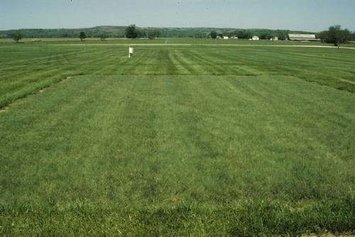
Buffalograss is an open growing grass that will not shade the soil as well as most of our other turfgrasses. Weeds are often the result. A regular mowing schedule can reduce broadleaf weed problems as most broadleaves cannot survive consistent mowing. Those that do either have a rosette growing pattern (dandelions, shepherds purse) or are “creepers” (henbit, chickweed, spurge). Annual grasses such as crabgrass or foxtail can also be a problem. A good weed preventer (prodiamine, pendimethalin or dithiopyr) may be needed prevent problems.
March
Spot treat broadleaf weeds if necessary. The most important treatment for broadleaf weeds should be in late October to early November well after the buffalograss is dormant. Treatments are much more effective then than in the spring as the weeds are smaller and the weeds are sending energy, as well as the herbicide, to the roots. Treatments in March are to take care of any “escapes” missed in the fall spraying. Spray early enough in March that the buffalograss is still dormant. Look at the base of the plants to make sure there is no green. Treat on a day that is 50 degrees F or warmer. Rain or irrigation within 24 hours of application will reduce effectiveness. Use a combination product such as Trimec, Weed-B-Gon or Weed-Out. Weed Free Zone is also good and will give quicker results under cool conditions.
April
Apply crabgrass preventer between April 1 and April 15, or apply preventer when the eastern redbud is in full bloom. If using a product with prodiamine (Barricade), apply two weeks earlier.
Crabgrass preventers must be watered in before they will work. Avoid using broadleaf herbicides as the buffalograss is greening up as injury can result. The buffalograss will not be killed but growth will slow making the buffalograss less competitive with weeds.
June
Fertilize with 1 lb. of nitrogen per 1,000 square feet during June. More applications will give a deeper green color, but will encourage weeds. If it is felt that a second application is needed, apply in July. If grubs have been a problem in the past, apply a product containing imidacloprid by mid July.
Imidacloprid can be applied as early as mid May if there are problems with billbugs or May beetle grubs. These products kill the grubs before they cause damage. They are effective and safe but must be watered in before they become active. Again, I would only treat if grubs have been a problem in the past. Note that the whole area may not need to be treated. The beetles that lay the eggs for the grubs are attracted to lights and moist soil and those areas are most likely to be infested.
Late-July through August
If you see grub damage, apply a grub killer. If imidacloprid has been applied or if grubs have not been a problem in the past, this should not be necessary. Grub killers must be watered in immediately.
Late October to Early November
Spray for broadleaf weeds if they are a problem. Look carefully as our winter annuals such as chickweed and henbit are small and easily overlooked. Use a product that contains 2,4-D as it increases effectiveness on dandelions. Treat on a day that is at least 50 degrees F. Rain or irrigation within 24 hours reduces effectiveness. Use the rates listed on the label for all products mentioned. (Ward Upham)
Lawn Calendar for Warm-Season Grasses
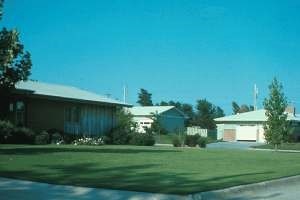
March
Spot treat broadleaf weeds if necessary. Treat on a day that is 50 degrees F or warmer. Rain or irrigation within
24 hours of application will reduce effectiveness.
April
Apply crabgrass preventer between April 1 and April 15, or apply preventer when the eastern redbud is in full bloom. If using a product with prodiamine (Barricade), apply two weeks earlier. Crabgrass preventers must be watered in before they will start to work.
May – August 15
Fertilize with 1 lb. of nitrogen per 1,000 square feet per application. Follow the recommendations on the bag. More applications will give a deeper green color, but will increase mowing and lead to thatch buildup with zoysiagrass. Bermudagrass can also have problems with thatch buildup but thatch is less likely with Bermuda than zoysia.
Bermudagrass – Use two to four applications.
Zoysiagrass – Use one to two applications. Too much nitrogen leads to thatch buildup.
One Application: Apply in June.
Two Applications: Apply May and July.
Three Applications: Apply May, June, and early August.
Four Applications: Apply May, June, July, and early August.
June
If grubs have been a problem in the past, apply a product containing imidacloprid by mid July. Imidacloprid can be applied as early as mid May if there are problems with billbugs or May beetle grubs. These products kill the grubs before they cause damage. They are effective and safe but must be watered in before they become active. June is a good time to core aerate a warm-season lawn. Core aeration will help alleviate compaction, increase the rate of water infiltration, improve soil air exchange and help control thatch.
Late-July through August
If you see grub damage, apply a grub killer. If Imidacloprid has been applied, this should not be necessary. Grub killers must be watered in immediately.
Late October
Spray for broadleaf weeds if they are a problem. Treat on a day that is at least 50 degrees F. Rain or irrigation within 24 hours reduces effectiveness. Use the rates listed on the label for all products mentioned. (Ward Upham)
Why Seeding Cool-Season Grass in the Spring is Difficult
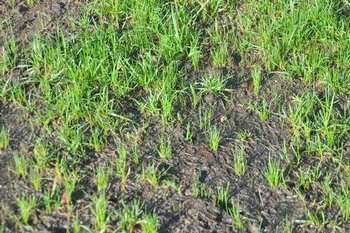
The soils are warmer in the fall. Warm soils mean less time required for germination and growth so the grass becomes established more quickly. I have seen tall fescue seeded in the last week of August come up in four days. Now, you had to be on your hands and knees to see it but it was up. Tall fescue seeded in the spring may take well over a week to come up and the time required to become established is much longer.
Weeds are less of a problem in the fall. The major weed problems in the fall tend to be the broadleaves such as chickweed, henbit or dandelion. Turf seeded in early September is usually thick enough by the time these broadleaves germinate that often there is not much weed invasion. Even if there is some invasion by broadleaves, the turf is usually mature enough by early November that mild broadleaf herbicides can be applied.
In the spring, our major weed problems are the annual grasses such as crabgrass. The number of chemicals that can be used on young turf is limited, and so these grasses become more of a problem. Also, since the spring-seeded turf is slow to mature, there are often thin areas that are easily invaded by these grassy weeds. If this invasion occurs, the weeds are better adapted to our summer conditions than our cool-season grasses and so the weeds tend to take over.
Summer is the hardest time of the year for cool-season grasses; not the winter. Summertime is very difficult because our cool-season grasses do not have the heat or moisture stress tolerance that our warm-season grasses such as buffalo, zoysia and bermuda have. Therefore they tend to become weakened in the summer which makes them more susceptible to disease and other stresses. Spring-seeded cool-season grasses are less mature and therefore less able to tolerate these stresses.
Seeding cool-season grasses in the spring can be successful but is more difficult to pull off than fall seedings. If you have a choice, always opt for seeding cool-season grasses in the fall. (Ward Upham)
Fruit:
Growing Blueberries in Containers
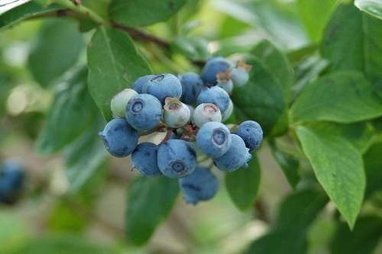
Acid soil pH: Blueberries need an acid pH between 4.8 and 5.2. Sphagnum peat moss is very acid and often used
in large quantities in soil mixes for acid-loving plants. In fact, blueberries can be grown in peat moss alone if nutrients are provided but that is an involved process. A 50/50 mix of peat moss and potting soil is recommended. This will provide nutrients and weight so the plant is less likely to blow over in wind.
Container size: Though containers as small as 2 gallons can be used for half-high blueberries, a larger container will be more stable in the wind and provide a larger moisture reserve during hot, dry weather.
Watering: Blueberries do not have root hairs, so they are not efficient in picking up water. Potting soil should be kept moist. This will likely be the most challenging aspect of growing blueberries in containers. A large container will not need to be watered as frequently as a small one.
Winter care: Though plants are winter hardy, the roots are not. Move pots into an unheated, attached garage or bury them in the soil or mulch enough to bury the pot in early November.
Water them periodically during the winter. Use your finger to determine if the soil is moist one inch deep. If not, then water until some flows out the bottom of the pot.
Varieties: Though blueberries will produce some fruit if only a single variety is grown, two varieties will increase the potential fruit crop. Suggested varieties include Top Hat and Northsky. Each should reach about 18 inches high, though Northsky will likely grow wider than Top Hat. Northblue is another choice that should produce more fruit than either Top Hat or Northsky but should reach 2 to 3 feet high. North Country is intermediate in size at 18 to 24 inches high and should produce a moderate amount of fruit.
Wind protection: Wind protection will decrease the amount of water these plants need and reduce the chances of leaf scorch.
Exposure: Blueberries do best with a minimum of 6 to 8 hours of sunlight a day. Try a northern or eastern exposure that is protected from the wind. (Ward Upham)
Growing Blueberries
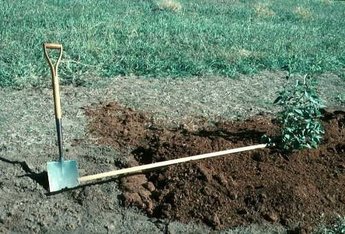
It is best to start planting preparations a year ahead of time to allow for pH adjustment, weed control, and the addition of organic matter. The first step is a soil test to determine how much the pH needs to be reduced. For a pH up to 5.5, the addition of sphagnum peat moss at the rate of 2 cubic feet per 100 square feet will be adequate. For a pH 5.5 to 6.0, add 1 pound of sulfur per 100 square feet of bed in addition to the peat moss. For a pH 6.0 to 6.5, add 1.5 pounds of sulfur per 100 square feet of bed. For pH levels above 6.5, use 2 pounds of sulfur per 100 square feet of bed and double the amount of sphagnum peat moss suggested earlier. Do not use aluminum sulfate to correct a high pH because excessive levels of aluminum can be toxic to blueberries. For each 0.5 movement up the pH scale from 6.5, add an additional pound of sulfur. Sulfur can be applied as a dust, but pelletized sulfur is much easier to spread.
Treat only the row. Row width should be 8 feet. Blueberries are normally spaced about 5 feet within the row. Sulfur takes time to react, so allow as much time as possible between sulfur application and planting. Blueberries will bear more if you plant more than one variety.
Recommended varieties vary, but you may want to try Bluecrop because it is adaptable. Patriot also seems to do well. You may want to try some other varieties. Blueberries should be mulched. Sawdust is the traditional material, but straw and wood chips will work as well. Mulch to a depth of about 3 inches.
Blueberries must be irrigated. Soils should be kept most but never waterlogged. Adding peat moss to the planting row will elevate the planting bed enough that standing water should not be an issue. An elevated bed will dry out more quickly, so there must be a means of adding water. Trickle irrigation works well. Watering twice a week during the summer with enough water to wet the soil 8 inches deep should be sufficient except under extreme heat. Watering once a week may be enough during the cooler spring and fall weather. As you might guess, there is more to growing blueberries than can be included in a short article. Dr. Art Gaus from the University of Missouri shared this instruction sheet on how to grow blueberries more than 25 years ago. It is still excellent information on blueberry culture. You can access it by going to: http://www.hfrr.ksu.edu/doc3091.ashx
Blueberries require commitment. Anything less than excellent preparation and care will result in failure. (Ward Upham)
Flowers:
Iris Leaf Spot Control Starts Now
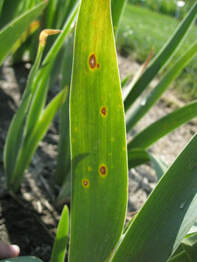
Because this disease overwinters in old leaves, removal and destruction of dead leaves will help with control. For plants that had little infection the previous year, this may be all that is needed. Plants that were heavily infected last year should be sprayed with chlorothalonil (Bravado Fungicide, Fertilome Broad Spectrum Landscape & Garden Fungicide, Ortho Garden Disease Control, GardenTech Daconil, Bonide Fungonil, Bravo Flowable Fungicide) or myclobutanil (Immunox, Immunox Plus) starting when leaves appear in the spring. Repeat sprays every seven to 10 days for four to six sprays. Iris leaves are waxy, so be sure to include a spreader-sticker in your spray to ensure good coverage. (Ward Upham)
Contributors: Ward Upham, Extension
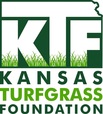

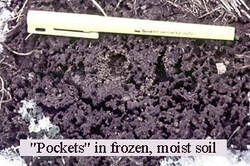
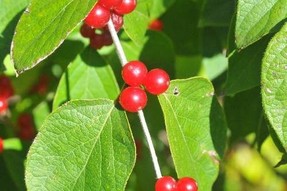
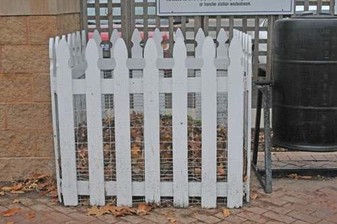
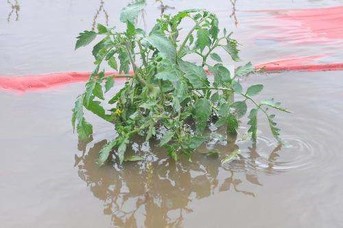
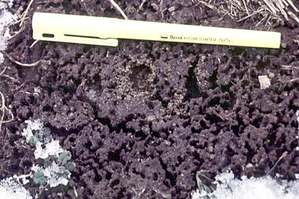
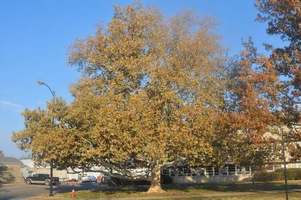
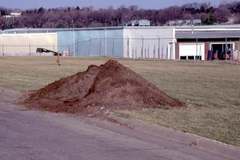
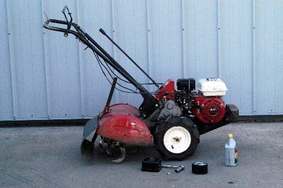
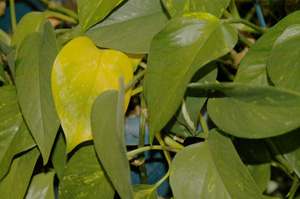
 RSS Feed
RSS Feed
